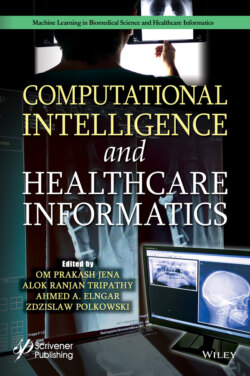Читать книгу Computational Intelligence and Healthcare Informatics - Группа авторов - Страница 39
2
Thoracic Image Analysis Using Deep Learning
ОглавлениеRakhi Wajgi1*, Jitendra V. Tembhurne2 and Dipak Wajgi2
1Department of Computer Technology, Yeshwantrao Chavan College of Engineering, Nagpur, India
2Department of Computer Science & Engineering, Indian Institute of Information Technology, Nagpur, India
Abstract
Thoracic diseases are caused due to ill condition of heart, lungs, mediastinum, diaphragm, and great vessels. Basically, it is a disorder of organs in thoracic region (rib cage). Thoracic diseases create severe burden on the overall health of a person and ignorance to them may lead to the sudden death of patients. Lung tuberculosis is one of the thoracic diseases which is accepted as worldwide pandemic. Prevalence of thoracic diseases is rising day by day due to various environmental factors and COVID-19 has trigged it at higher level. Chest radiography is the only omnipresent solution utilized to capture the abnormalities in the chest. It requires periodic visits by patient and timely tracking of findings and observations from the chest radiographic reports. These thoracic disorders are classified under various classes such as Atelectasis, Pneumonia, Hernia, Edema, Emphysema, Cardiomegaly, Fibrosis, Pneumothorax, Consolidation, Pleural Thickening, Effusion, Infiltration, Nodules, and Mass. Precise and reliable detection of these disorders required experienced radiologist. The major area of research in this domain is accurate localization and classification of affected region. In order to make accurate prognosis of chest diseases, research community has developed various automated models using deep learning. Deep learning has created a massive impact in terms of analysis in the domain of medical imaging where unprecedented amount of data is generated daily. There are various challenges faced by the community prior to model building. These challenges include orientation, data augmentation, colour space augmentation, and feature space augmentation of image but are pragmatically handle by various parameters and functions in deep learning models by maintaining their accuracies.
This chapter aims to analyse critically the deep learning techniques utilized for thoracic image analysis with respective accuracy achieved by them. The various deep learning techniques are described along with dataset, activation function and model used, number and types of layers used, learning rate, training time, epoch, performance metric, hardware used, and type of abnormality detected. Moreover, a comparative analysis of existing deep learning models based on accuracy, precision, and recall is also presented with emphasize on the future direction of research.
Keywords: Accuracy, classification, deep learning, localization, precision, recall, radiography, thoracic disorder
